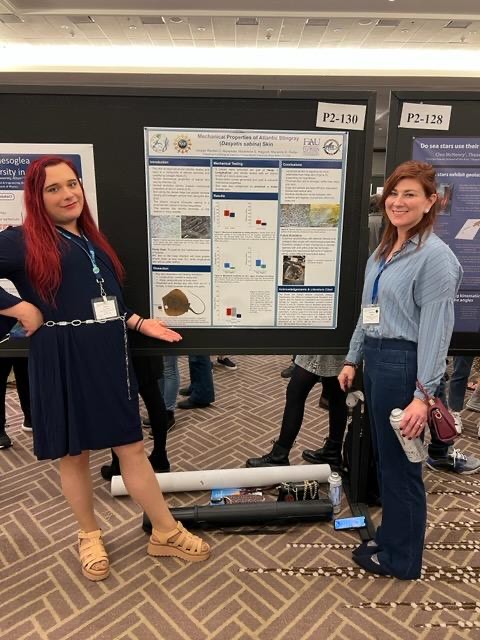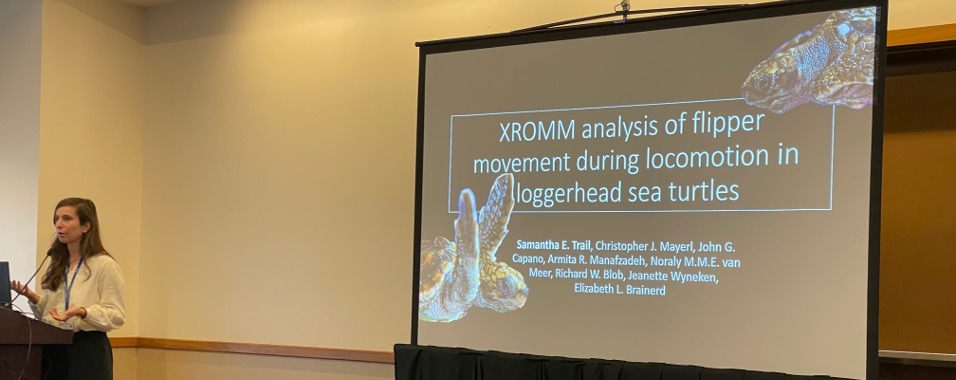
Author: Sam Trail
Date: January 26, 2023
To kick off the new year in science style, many researchers traveled from around the world to attend the Society for Integrative & Comparative Biology (SICB) annual conference. The FAU Marine Lab always has a strong presence from principal investigators, graduate and undergraduate students, and this year was no exception. Members of Dr. Marianne Porter’s FAB (Florida Atlantic Biomechanics) Lab and Dr. Jeanette Wyneken’s Sea Turtle Lab traveled to Austin, Texas to share their work with scientists for 5 full days of groundbreaking research presentations. For those that didn’t make the trip, don’t worry we have you covered! Read below to learn about some of the wonderful work that was presented:
PhD candidate Madeleine Hagood gave a talk entitled “Exotendon or not? Mechanical anisotropic behavior of shark skin.” Sharks possess dermal denticles which are scales similar to small teeth. This is why their skin feels a lot like sandpaper. Madeleine’s results included mechanical properties, denticle density, and collagen fiber angles of shark skin in 18 different species. Her results support the exotendon hypothesis, which means shark skin functions like a passive spring that can aid locomotion, similar to the sole of a fitness shoe.

Undergraduate researcher and lab technician, Joseph Alexander, presented a poster “Mechanical properties of Atlantic Stingray (Dasyatis sabina) skin.” Just like sharks, some batoids (rays and skates) also possess this toothy armor! Joseph’s study is the first of its kind to examine the mechanical properties of batoid skin that possess dermal denticles!
PhD candidate Ivana Serra gave a talk entitled “Mechanical behavior of sea turtle shells throughout ontogeny.” Despite its seemingly protective role, little attention has been given to the mechanical properties of marine turtle shells, especially throughout their life span or development (ontogeny). Ivana’s work reveals that sea turtle shells are much less stiff than other turtles, and differences in strength and toughness likely also exist between different sea turtle species and life stages.

PhD student Aubrey Clark presented a poster “Comparative three-dimensional olfactory morphology of requiem sharks.” Olfactory rosettes (smelling structures in sharks) vary in size and shape among species, but there is no clear explanation as to why. Aubrey is untangling this mystery using a microCT scanner (similar to a CAT scan) to quantify rosette morphology and create 3D models of these organs. These models will soon be used to investigate the effects of morphological variation on the hydrodynamics through the shark olfactory system.
Postdoctoral Fellow Dr. Lauren Simonitis gave a talked entitled “Nosy About Noses: using biovisualization techniques to study Chondricthyan nasal morphology.” Not only do olfactory rosettes come in different shapes and sizes, but those structures vary in sensitivity. Lauren is testing if those varying degrees of sensitivity could be related to water flow through those structures. Her work involves combining CT scans, scanning electron microscopy, and histology to build models of cartilaginous fish noses. These models can then be used to examine the effects of speed, angle of attack, and morphology of the nares on the flow through the rosettes.
PhD student Samantha Trail gave a talk entitled “XROMM analysis of flipper movement during locomotion in loggerhead sea turtles.” During this presentation, Samantha showed how bones in the flipper and shoulder joint move to produce the elaborate sea turtle powerstroke using X-ray Reconstruction of Moving Morphology (XROMM). The powerstroke is the predominant swimming gait of sea turtles and differs from the “flapping” locomotion of other animals. XROMM combines CT scans and X-ray video to animate bone models in 3D space for visualization and quantification.
The learning doesn’t stop here! Around 900 presentations from this event have been uploaded to the SICB+ virtual platform. This content will be available through March 17th, 2023, and you can register to view it here.
As always, SICB was a wonderful time for our FAU Marin Lab scientists and collaborators to share their work with a broader audience. We are already counting down to SICB 2024 in Seattle, WA!
